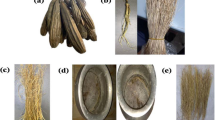Abstract
This study evaluated the effect of biopolishing using cellulase enzymes on the low stress mechanical properties, microstructure, and dye uptake of different cellulosic fabrics (cotton, modal, and cotton denim). The tactile features were studied via the Kawabata evaluation system (KES) and showed increments in tensile elongation, tensile resilience and surface properties leading to wearing comfort, whereas the enhanced shear and bending properties of yarns in the fabrics became stronger and more rigid. The surface morphology of the cellulosic fabrics was evaluated by scanning electron microscopy (SEM), and the results indicated that the surface of the treated fabrics became smooth and polished. Biotreatment enhanced comfort, luster, and smoothness without affecting other important properties of the fabrics. The effect of biopolishing before and after the dyeing process has been studied. This was the first study to compare cotton, modal, and denim fabrics for the evaluation of low-stress mechanical properties by employing biopolishing.
Similar content being viewed by others
References
A. Madhu and J. N. Chakraborty, J. Clean. Prod., 145, 114 (2017).
H. Nolte, D. P. Bishop, and Höcker, J. Text. I., 87, 212 (1996).
T. W. Shyr, P. N. Wang, and K. B. Cheng, Fibres Text. East. Eur., 15, 81 (2007).
A. K. Choudhary and P. Bansal in “Manikins for Textile Evaluation”, 1st ed. (R. Nayak and R. Padhye Eds.), p.173, Woodhead Publishing, 2017.
S. Srivastava, “The Basics of Fashion Technology”, Pushpa Publishing House, India, 2012.
S. Madhav, A. Ahamad, P. Singh, and P. K. Mishra, Environ. Qual. Manage., 27, 31 (2018).
H.-J. Jo, E.-J. Park, K. Cho, E.-H. Kim, and J. Jung, Chemosphere, 70, 949 (2008).
N. M. Sivaram, P. M. Gopal, and D. Barik in “Energy from Toxic Organic Waste for Heat and Power Generation”, 1st ed. (D. Barik Ed.), Woodhead Publishing, 2019.
M. Montazer and T. Harifi, “Nanofinishing of Textile Materials”, 1st ed., pp.1–17, Woodhead Publishing, 2018.
S. Shah, Res. J. Eng. Sci., 3, 1 (2014).
A. Sarkar and J. Etters, J. Cotton Sci., 8, 254 (2004).
D. Saravanan, N. S. Vasanthi, and T. Ramachandran, Carbohydr. Polym., 76, 1 (2009).
N. A. Ibrahim, K. EL-Badry, B. M. Eid, and T. M. Hassan, Carbohydr. Polym., 83, 116 (2011).
N. A. Ibrahim, M. El-Hossamy, M. M. Hashem, R. Refai, and B. M. Eid, Carbohydr. Polym., 74, 880 (2008).
C. W. Kan and C. H. Au, Carbohydr. Polym., 101, 451 (2014).
J. Sheikh and I. Bramhecha in “The Impact and Prospects of Green Chemistry for Textile Technology”, 1st ed. (S. ul-Islam and B. S. Butola Eds.), p.135, Woodhead Publishing, 2018.
B. Tiber and H. E. Balcıoğlu, Polym. Compos., 40, 217 (2019).
R. H. Yang, C. W. Kan, W. Y. Wong, and M. C. Law, Fiber. Polym., 14, 669 (2013).
L. Hao, R. Wang, L. Wang, K. Fang, J. Liu, and Y. Men, Cellulose, 23, 929 (2016).
A. Kumar and A. Harnden, Text. Chem. Color. Am. Dyest. Rep., 31, 37 (1999).
S. Kalantzi, D. Mamma, P. Christakopoulos, and D. Kekos, Bioresour. Technol., 99, 8185 (2008).
M. Calafell and P. Garriga, Enzyme Microb. Tech., 34, 326 (2004).
A. Cavaco-Paulo, J. Cortez, and L. Almeida, J. Soc. Dyers Colour., 113, 218 (2008).
E. Nithya, R. Radhai, R. Rajendran, S. Shalini, V. Rajendran, and S. Jayakumar, Carbohydr. Polym., 83, 1652 (2011).
J. J. Kaschuk, T. M. Lacerda, V. Coma, and E. Frollini, Cellulose, 24, 2437 (2017).
T. Haga and T. Takagishi, J. Appl. Polym. Sci., 80, 1675 (2001).
N. Sankarraj and G. Nallathambi, Carbohydr. Polym., 191, 95 (2018).
A. A. U. de Souza, F. C. S. Ferreira, and S. M. A. G. U. Souza, Carbohydr. Polym., 93, 412 (2013).
N. Varghese and G. Thilagavathi, J. Text. Apparel, Technol. Manag., 8, 1 (2014).
C. Q. Yang, W. Zhou, G. C. Lickfield, and K. Parachura, Text. Res. J., 73, 1057 (2003).
M. L. Gulrajani, R. Agarwal, A. Grover, and M. Suri, Indian J. Fibre Text., 25, 69 (2000).
R. Betcheva, M. Stamenova, C. Boutris, and T. Tzanov, Macromol. Mater. Eng., 288, 957 (2003).
C. S. Viswanath, Indian J. Fibre Text., 35, 342 (2010).
S. Verenich, K. Arumugam, E. Shim, and B. Pourdeyhimi, Text. Res. J., 78, 540 (2008).
M. Yamada, Y. Amano, E. Horikawa, K. Nozaki, and T. Kanda, Biosci. Biotechnol. Biochem., 69, 45 (2005).
G. Buschle-Diller, Y. El Mogahzy, M. K. Inglesby, and S. H. Zeronian, Text. Res. J., 68, 920 (1998).
P. S. Vankar and R. Shanker, Desalination, 230, 62 (2008).
Acknowledgements
The authors acknowledge the ICAR Central Institute for Research on Cotton Technology (ICAR-CIRCOT), Mumbai, for providing facilities to carry out this work. The authors are also thankful to the Institute of Chemical Technology (ICT), Mumbai, for providing experimental and testing support. We also acknowledge the three anonymous reviewers for their valuable comments on our manuscript, which helped us improve the manuscript significantly.
Author information
Authors and Affiliations
Corresponding author
Rights and permissions
About this article
Cite this article
Kumar, M., Shukla, S.R., Arputharaj, A. et al. Biopolishing of Cellulosic Fabrics: A Study on Low-Stress Mechanical Properties, Microstructure, and Dye Uptake. Fibers Polym 22, 2803–2814 (2021). https://doi.org/10.1007/s12221-021-0356-8
Received:
Revised:
Accepted:
Published:
Issue Date:
DOI: https://doi.org/10.1007/s12221-021-0356-8




